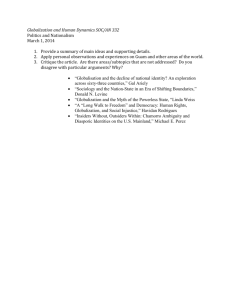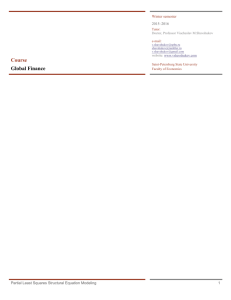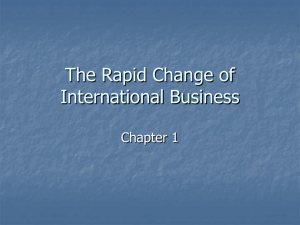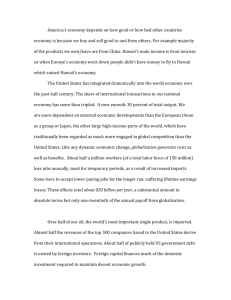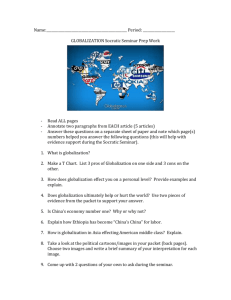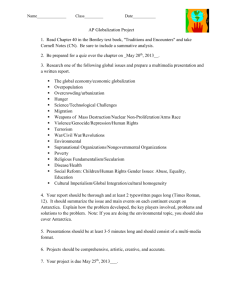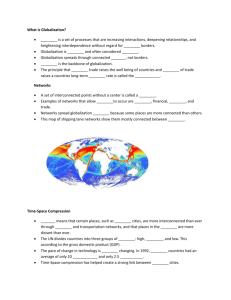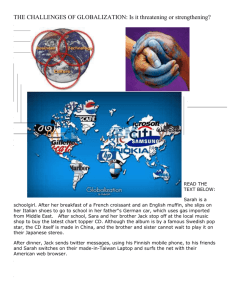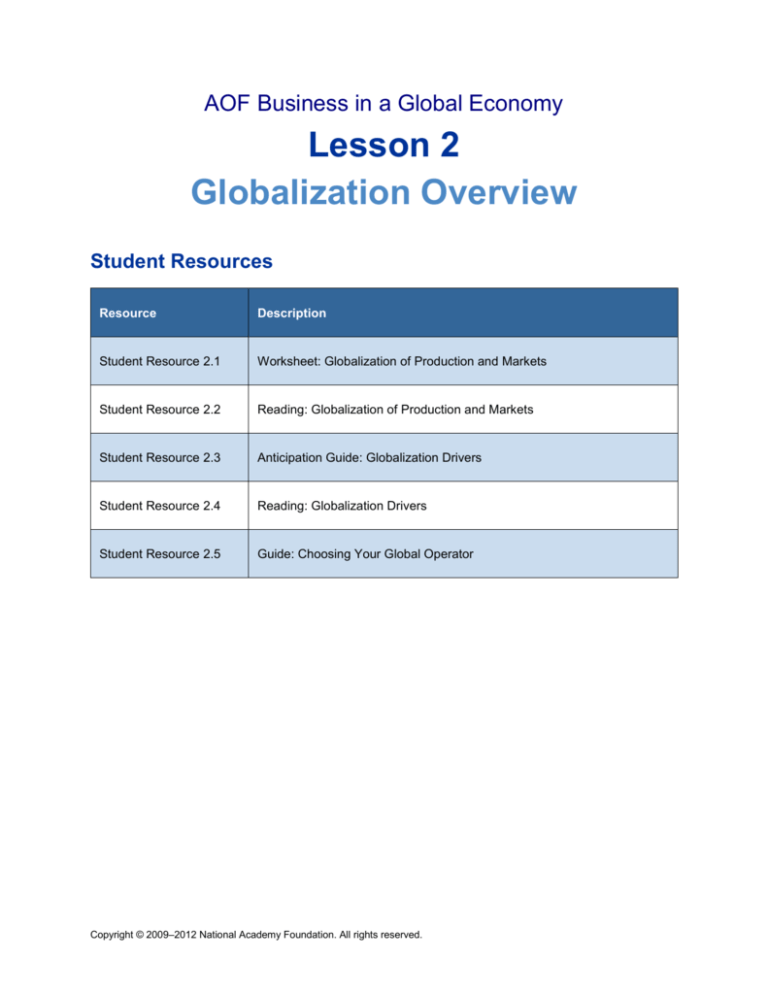
AOF Business in a Global Economy
Lesson 2
Globalization Overview
Student Resources
Resource
Description
Student Resource 2.1
Worksheet: Globalization of Production and Markets
Student Resource 2.2
Reading: Globalization of Production and Markets
Student Resource 2.3
Anticipation Guide: Globalization Drivers
Student Resource 2.4
Reading: Globalization Drivers
Student Resource 2.5
Guide: Choosing Your Global Operator
Copyright © 2009–2012 National Academy Foundation. All rights reserved.
AOF Business in a Global Economy
Lesson 2 Globalization Overview
Student Resource 2.1
Worksheet: Globalization of Production and Markets
Student Name:_______________________________________________________ Date:___________
Directions: Read the statements below and, while listening to the class presentation on the same topic,
focus on finding answers to these real-life questions that professionals are facing. Your teacher will give
you hints on how to approach the issues.
1. Sony, Nintendo, and Microsoft are among the leading players in the video game market in the US
If these companies compete globally, explain why this is a case of:
___ Globalization of markets
OR
___ Globalization of production
2. Describe what makes a computer or an airplane a “global product.”
3. A hospital sends your MRI scan to a medical worker in India for analysis. Is this an example of
globalization of markets or globalization of production? Why?
Copyright © 2009–2012 National Academy Foundation. All rights reserved.
AOF Business in a Global Economy
Lesson 2 Globalization Overview
Student Resource 2.2
Reading: Globalization of Production and Markets
When businesses expand their markets or production operations beyond the borders of their home
country, they are globalizing.
Globalization causes political, economic, and cultural changes. Until recently, it took years for many
people to feel these effects. International travel was slow and costly; so was freight transport.
International telecommunications (phone calls, for example) were limited and expensive. Tariffs (taxes on
imports), and quotas (limits on the goods allowed to be imported) also restricted globalization. Changes
caused by globalization were gradual and often went unnoticed.
With today’s technology, and with trade barriers reduced through international agreements, globalization
is likely to continue to change the world with increasing speed.
These changes can be viewed as positive or negative, depending on who is looking at them and from
what perspective. Either way, globalization seems to have changed the world permanently, and continues
to do so every day. In this course, we will look at globalization from the business perspective, learning
about how and why companies choose to globalize and how doing so helps firms stay competitive in the
global marketplace, where more and more businesses compete every day.
Copyright © 2009–2012 National Academy Foundation. All rights reserved.
AOF Business in a Global Economy
Lesson 2 Globalization Overview
What causes a business to decide to enter the global marketplace? There are many reasons, and they
include, reducing labor costs, expanding markets, and increasing brand awareness, all of which can
increase profit. As more and more citizens of the world become consumers, more and more products are
sold. Globalization stimulates demand by marketing goods to new categories of customers in more
places. Globalization tends to increase supplyand sometimes also incomesin developing countries,
through an influx of investment and technology from multinational corporations. In this way, globalization
can sometimes create its own customers. If a company from the United States hires workers in the
Dominican Republic to make its products in a factory, the company saves on labor costs compared with
wages it would have paid in the US. The workers in the Dominican Republic are then able to afford
products they previously could not. Thus, globalization creates new jobs and new consumers.
How do these goods get to the new consumers? Relatively inexpensive travel and freight transportation
by air; the development of freight-container technology for shipping, and efficient and cheap
telecommunications (inexpensive international phone calls; e-mail and the Internet) all contribute to
making it easy and quick for products to move all over the world. The Internet allows people from all over
the world to purchase goods and services across borders quickly and easily.
As the standard of living of people all over the world rises, so does their disposable income, and so they
are able to buy more, keeping globalization growing.
Copyright © 2009–2012 National Academy Foundation. All rights reserved.
AOF Business in a Global Economy
Lesson 2 Globalization Overview
Companies compete in the international economy through globalization of markets, globalization of
production, or both.
Factors contributing to the globalization of markets include the existence or improvement of many
different kinds of systems, institutions, or infrastructures through which people exchange goods, services,
and/or information.
A national insurance company that goes into business abroad, offering insurance policies adapted to the
requirements of the various new markets it enters, is an example of a company both responding to the
globalization of markets and also contributing to the globalization of markets. A multinational commercial
bank, which provides business customers with banking services across many different countries, is also
an example of a company competing in the international economy through the globalization of markets.
Globalization of production is when companies move and/or expand their manufacturing internationally, to
reduce labor costs or for other reasons. Production includes the machines, tools, and labor required to
make things for sale. A small clothing designer who pays a factory abroad to sew its clothes, or a car
company that has its parts assembled in a factory in another country, are examples of globalization of
production. Similarly, a national insurance company that hires a call center abroad to perform all or some
of its customer service functions is also an example of globalization of production.
Copyright © 2009–2012 National Academy Foundation. All rights reserved.
AOF Business in a Global Economy
Lesson 2 Globalization Overview
A market is a place where buyers and sellers meet to exchange goods, services, or information.
Traditionally, markets were defined by geographical borders, so many industries had different markets for
different countries. Today, national markets are merging into one global market because even small
companies can reach customers worldwide. For instance, the representative of a US solar panel
manufacturer can meet potential customers from all over the world at industry trade shows, or even via
the Internet. This process of national markets merging together is called globalization of markets.
Globalization of markets occurs when goods, services, or information are traded across borders.
While many of the most famous global companies, such as Starbucks, McDonald’s, and IBM are large
ones, with prominent brands that hold strong appeal to people of different nations, technology enables
companies of all sizes to conduct business internationally, facing competition all over the globe.
Copyright © 2009–2012 National Academy Foundation. All rights reserved.
AOF Business in a Global Economy
Lesson 2 Globalization Overview
Markets can be thought of as being divided into two markets: consumer and industrial. Industrial markets
are truly global; in these markets, there is typically a limited number of suppliers, but a universal need for
their products. Among such markets are 1) markets for commodities such as oil, aluminum, copper, or
sugar; 2) markets for industrial products such as commercial jet aircraft or earthmoving equipment; 3)
foreign exchange markets where different currencies are exchanged, and; 4) markets for financial assets,
which include markets for bonds, stocks, and currencies.
Copyright © 2009–2012 National Academy Foundation. All rights reserved.
AOF Business in a Global Economy
Lesson 2 Globalization Overview
To be able to compete in the global marketplace, firms source goods and services from all over the world.
Making most products requires multiple stages of production: raw materials turn into intermediate goods,
passing through many stages before becoming a finished good. For each stage of production, a company
has an opportunity to search for the best choice of producer (in terms of capability and cost) to add value
to the good or service it sells. The process of adding value to the good or service in a sequence of stages
is known as the value chain. In a global economy the search for the best choice of producer is worldwide
in scope. As a result, companies’ value chains often involve production activities in multiple countries,
carried out by a variety of different suppliers of goods or services.
Firms take advantage of global markets to seek out the best (for them) choices of inputs for production,
making use of the different costs and quality of labor, capital, land, and other available inputs for
production all over the globe. Searching for the best fit in terms of the labor, capital, and/or land that a
firm buys is called sourcing. When companies engage in global sourcing, companies seek out the best
combination of quality and cost for them, regardless of location. It is important to keep in mind that
sourcing refers to searching the world not only for raw materials, but also for final goods, employees,
knowledge, innovation, and financing.
Labor costs vary widely throughout the world, and one reason that many businesses source labor globally
is that it will ultimately make their products cheaper to consumers. It is not only the hourly wage of
workers, but other factors, including the presence or absence of labor unions, that makes labor costs so
different.
Copyright © 2009–2012 National Academy Foundation. All rights reserved.
AOF Business in a Global Economy
Lesson 2 Globalization Overview
Outsourcing, or offshoring, are terms for transferring certain parts of the management and/or day-to-day
operations of a business to an outside supplier abroad. For example, many US companies have
outsourced their telephone-based customer service activities to locations in India. Bangalore, India, is a
hub for information services and technology, and is called the Silicon Valley of India. Many call centers for
US companies, even for quite technical functions such as help desks supporting a software product, are
located in Bangalore and other Indian cities. There are schools in India that teach workers how to
converse with customers in an American manner, and even to speak with American accents. Providing
service over the phone from India became possible and profitable because of high-quality, inexpensive
telephone communications, and computer technology that usually puts the right information at the
customer service agent’s fingertips. Without modern technology, this form of globalization would not be
possible.
The most prevalent reason companies choose to outsource internationally is to cut costs. US companies
originally outsourced manufacturing, but soon the advances of Internet/communication technology made
it possible to extend outsourcing to services like call centers In addition to cost savings, globalization
allows work to go on 24 hours a day.
India is a frequent choice for offshoring because of the availability of highly skilled and low-cost labor by
people who speak and write English well.
Copyright © 2009–2012 National Academy Foundation. All rights reserved.
AOF Business in a Global Economy
Lesson 2 Globalization Overview
Globalization has changed the world, probably forever. People all over the world enjoy benefits from
globalization, but also pay a price for it. People have mixed feelings about the impact of globalization;
what some people may see as a benefit of globalization, others may see as a downside. For instance, the
emergence of a global economy has allowed China to become an increasingly important economic force
over the past decade. Because of their increasing economic power, China is on track to become a major
world power.
Some people, probably including most of China’s one and a half billion residents, are happy about
China’s emergence as a very large economy, and potentially as a world power; and may see this change
as a benefit of globalization. Others, including many environmentalists, feel that China’s economic
growth, much of it involving ecologically damaging practices in manufacturing, electricity generation, and
other activities, represents a downside of globalization, even though it generates jobs and income in
China.
Many critics of globalization argue that relocating manufacturing and service activities from the United
States to China (and to other emerging economies where wages are low) adversely affects workers in the
US, depressing employment and incomes, at least for people with limited education and skills. Others
disagree, arguing that everyone will eventually benefit from increased economic growth associated with
globalization. They point out that the reverse is true as well: many companies based outside the US, such
as BMW, Subaru, and Nissan, have manufacturing plants in the US.
Many of the changes caused by globalizing the economy can be seen as positive or negative, depending
on one’s point of view.
Copyright © 2009–2012 National Academy Foundation. All rights reserved.
AOF Business in a Global Economy
Lesson 2 Globalization Overview
Student Resource 2.3
Anticipation Guide: Globalization Drivers
Student Name:_______________________________________________________ Date:___________
Directions: For each of the statements below, underline “I agree” if you think the statement is accurate or
“I disagree” if you disagree with it. Write one reason to explain your guess. Then take notes on what you
learn about this topic in the assigned reading.
Only large companies benefit from globalization.
My guess:
I agree I disagree
My reason:
I learned:
Globalization happens quickly because of advances in communications technology that make
it easier and faster for companies to obtain necessary information and negotiate deals.
My guess:
I agree I disagree
My reason:
I learned:
Freight (shipping) costs between countries have fallen for air and marine cargo, while
delivery times for goods have shortened.
My guess:
I agree I disagree
My reason:
I learned:
Taxes collected by customs for goods that cross international borders have been more or
less the same in the past 50 years.
My guess:
I agree I disagree
My reason:
I learned:
Copyright © 2009–2012 National Academy Foundation. All rights reserved.
AOF Business in a Global Economy
Lesson 2 Globalization Overview
Student Resource 2.4
Reading: Globalization Drivers
You may have heard people say that the world moves fast. One reason people feel this way is because of
globalization, in which goods, capital, and labor move more freely across international borders. Three
important factors have made the world seem to move at such a fast pace. They are called drivers of
globalization.
1. Reduction of Trade Barriers: Historically, governments have often protected businesses in their
country against foreign competition by imposing trade barriers. Barriers made it difficult for a supplier from
one country to sell its products in other countries. Common types of trade barriers are tariffs and duties,
taxes on goods moved across national boundaries. Limits on the quantity of a particular product imported
into a particular country (known as quotas) used to be common also.
After World War II, many industrialized countries began reducing or removing trade barriers, through
agreements with other countries. Most countries involved took part in the negotiations for the General
Agreement on Tariffs and Trade (GATT), starting in 1947. In 1995, GATT was absorbed into a newly
created institution, the World Trade Organization (WTO). The GATT negotiations, now held through the
WTO, are called “Rounds”. Each successive Round resulted in a big reduction in trade barriers, cutting or
abolishing specific tariffs, quotas, and other barriers. Other agreements between pairs of countries
(“bilateral” agreements), or among smaller groups of countries, also contributed. As a result, for many
products the barriers are now gone in most countries, or are insignificant. The latest Round, the Doha
Round, started in Doha, Qatar in 2001 and is still going on, with WTO member countries meeting
periodically to discuss remaining trade barriers
2. The Internet and communications technology: Technological change has intensified globalization.
Instant access to information, and the ability to communicate 24 hours a day, allows firms to have fuller
and more timely information on global markets in order to manage worldwide operations. Well-managed
companies can use improved computer systems and applications to cut production costs and enhance
productivity. As prices for communications decline, so do the costs of doing business internationally. The
Internet, fiber optic cables (on land and under the sea), satellites and wireless technology all help
businesses make sales, negotiate pricing, and process orders quickly and easily, reducing costs and
enhancing performance. Some buyers and sellers can find each other only with the help of electronic
global marketplaces. Web-based applications allow American companies to send their tax preparation to
the Philippines, MRI scans to India, and software updates to Eastern Europe, saving the American
companies money and time. In the past, businesses had only phones or letters to contact businesses
abroad. In the early 1990s, it cost $50 for a 10-minute call to much of Latin America. Today, with a
competitive market for communications, and with advanced technologies such as Skype available, this
call costs little or nothing. Not only does technology allow people all over the world to do business
together easily, it also allows them to do it inexpensively.
3. Transportation technology: One of the most important innovations in global business was freight
containerization, which became widespread in the 1970s. Shippers can load goods into containers using
automated or semi-automated cranes, and then place them onto ships, trains, or trucks without opening
and reloading them; they can also track the containers electronically. This process has made shipping
faster, cheaper and more reliable.
Fast, low-cost and reliable air travel and air freight has also had a big impact. Airplanes allow freshly cut
flowers from Colombia to reach US retail stores in a single day, or fresh California strawberries to make it
to European consumers in the winter in a matter of hours. People can move about quickly and easily, and
work and leisure travel has helped make global brands like such as Gap, Levi, Nike, Coca-Cola, Apple,
and Sony recognizable worldwide.
Copyright © 2009–2012 National Academy Foundation. All rights reserved.
AOF Business in a Global Economy
Lesson 2 Globalization Overview
These three drivers of globalization have given people and businesses more opportunities than ever
before. They can now participate in a global, not just a domestic, economy. Being part of a larger market
also means facing international competition for goods, services, and labor.
Copyright © 2009–2012 National Academy Foundation. All rights reserved.
AOF Business in a Global Economy
Lesson 2 Globalization Overview
Student Resource 2.5
Guide: Choosing Your Global Operator
Student Names:_________________________________________________ Date:__________
Directions: Read the two scenarios that describe businesses that are looking to expand into the global
market. Next, consider each scenario as you read the descriptions of the eight countries the businesses
have to choose from. With your group members, choose the two countries that make the best fit for each
scenario, and rank them by assigning one your top choice, and one your second choice. Then, write
down two reasons for your rankings and be ready to share your answers with your classmates. Finally,
write a paragraph about one of the countries you ranked as your top choice and explain, in detail, how
you arrived at your ranking.
Scenario 1: General Technologies
General Technologies is one of the top manufacturers of espresso machines in the United States. Over
the past few months, General Technologies has seen an increase in sales for its Personal Mocha Model,
which is an inexpensive machine for home kitchens. General Technologies’ executives are expecting
consumer demand for low-cost espresso machines to increase. To meet this demand, General
Technologies wants to open a factory somewhere in the developing world where manufacturing costs will
be as low as possible. The company needs to build the factory in a location where it will be easy to ship
the espresso machines, which are large and fairly heavy, to the United States. Company executives think
that it will be relatively easy to train new factory workers.
Scenario 2: MyFashionFriends
MyFashionFriends was featured on Good Morning America a couple months ago, and since then it has
been growing faster and faster. The social networking site, which two friends created in their spare time,
lets users connect and discuss fashion and shopping with their friends through text messages, cell phone
pictures, and other mobile communication. Although MyFashionFriends is thrilled by the rapid growth, it is
also having trouble accommodating all of the new users, particularly during shopping hours on the
weekends. Its system is having trouble processing and resending mobile messages, causing delays and
system outages. If users get frustrated with the system, they may stop using it. Because
MyFashionFriends is a young company, it does not have much money to hire employees. It needs lowcost programmers who can also be trusted to do an excellent job resolving problems involving the
weekend shopping rush.
Copyright © 2009–2012 National Academy Foundation. All rights reserved.
AOF Business in a Global Economy
Lesson 2 Globalization Overview
Country Choices
Brazil: One of the fastest-growing countries in Latin America, Brazil is a large exporter of machines and
other factory products. Located approximately 4,000 miles from the United States, it has an experienced,
highly regarded factory workforce. Laborers in Brazil earn more money than the average factory worker in
the developing world, though much less than their US counterparts. After years of political turmoil, Brazil
became a democracy in 1985. In the years since, the government has stabilized and Brazil has become a
major power in Latin America with a large economy. This shift has been accompanied by growth in
technological capabilities as computer makers and other high-tech companies have established research
facilities as well as production in Brazil. Several of Brazil’s domestic initiatives in high-tech industry (e.g.,
the aircraft company Embraer) have also prospered. Poverty, however, remains harsh among very many
people, and a large gap exists between the incomes of rich, middle-income, and poor people.
Cambodia: Cambodia has emerged in recent years as an option for outsourced factories. Currently
known for manufacturing clothing, Cambodia offers tax breaks to companies that locate factories making
consumer products in their country. Workers there have little manufacturing experience but also work for
less money than workers in most countries. Cambodia holds elections, and has some aspects of
democratic institutions, but is not a full democracy, Violence and protests can often accompany elections;
dissent is often suppressed. Literacy rates are low, and few Cambodians have experience working with
computers or other high tech equipment.
India: Technology companies have looked to India for years for computer programmers who understand
American technology. Companies can quickly and easily locate talented computer programmers in India
who have track records of producing superior work. However, these employees, though much less
expensive than their US counterparts, are more expensive than many other employees in the developing
world. High-level technical and scientific education in India is often of very high quality, and there are
large numbers of well qualified graduates. India functions on a different schedule from the United States,
and it may not always be possible to find workers available during American business hours. Despite
India’s reputation as a technology hub, two-thirds of Indians work as farmers. This number is decreasing
as Indians move from farm work to manufacturing and high-tech work. The largest democracy in the
world, India has a stable government and legal system and a rapidly growing economy. Despite this
growth, inequality remains high and India is subject to social unrest; in several regions there are
significant armed insurgencies. Additionally, there is tension between India and Pakistan over the
disputed Kashmir region, which has occasionally flared into localized armed incidents.
Costa Rica: A recent entrant in the global technology market, Costa Rica employs a growing but
relatively inexperienced corps of high-tech workers. Because of this, locating high-skilled labor in Costa
Rica, while possible, can be somewhat expensive and time consuming. Costa Rican computer
programmers work at somewhat lower pay rates than other programmers in the developing world.
Because Costa Rica shares a time zone with the United States, employees can work during American
business hours. The most stable democracy in Latin America, Costa Rica has not had any major social
unrest since 1948. Because of this stability, plus high literacy and favorable tax credits, many
manufacturers have begun to locate factories there. Wages for basic factory work can be somewhat high
compared to other developing countries, although not compared to wages in the United States. Costa
Rica’s government imposes strict environmental regulations on manufacturing, which may sometimes
increase manufacturing costs. However, this is not necessarily so where modern manufacturing is used,
since the most productive new technology and practices are often also the cleanest environmentally.
China: The most populated country in the world, China has enjoyed one of the fastest rates of economic
growth in the world for more than two decades. China’s boom stems mainly from phenomenal growth in
manufacturing and factory work. Gains in manufacturing are linked to improvements in education and the
development of high tech industrial capabilities. Additionally, wages for factory and high tech workers
have increased dramatically. While China has grown considerably wealthy during this time, many rural
Chinese citizens still live in extreme poverty. In fact, many citizens still live on less than $2 per day. Run
Copyright © 2009–2012 National Academy Foundation. All rights reserved.
AOF Business in a Global Economy
Lesson 2 Globalization Overview
by a single-party government, China’s political system is not democratic. Many observers worry that
China could experience significant civil unrest if growth slows.
Vietnam: The site of a 15-year war with the United States in the 1960s and 1970s. Vietnam has since
resolved its differences with the US and the two countries have become major trading partners. According
to the CIA World Factbook, Vietnam’s exports to the United States grew a remarkable 900 percent
between 2001 and 2007. This, coupled with internal political reforms, has helped Vietnam become one of
the fastest-growing economies in the world in the past decade. Still, Vietnam remains poorer than many
countries and wages are low by world standards. It the past few years, Vietnam has made an effort to
develop a high tech industry. Although its workers are cheap, Vietnam suffers from power outages and
other technical issues that impair high tech industries. Its single-party government tries to control political
expression, which occasionally leads to protests and other social unrest.
Mexico: Located just south of the United States, Mexico has a rapidly growing economy. Thanks, in part,
to its participation in numerous free trade agreements such as NAFTA, manufacturing in the country has
boomed for more than a decade. Despite a stable, democratically elected government and a relatively
strong economy, Mexico suffers from a large amount of economic and social inequality. Laborers in rural
areas have low literacy rates, short life expectancies and other markers of poverty while some urban
residents have fairly affluent lifestyles. Similarly, there is a wide gulf between the North and South. While
many US manufacturers have located factories in the northern states, Mexico’s southern states have little
industry. Tensions have boiled over in the south in recent years and Mexico has been the site of two
major massive protests in the last 15 years. Though computer and Internet usage has grown in recent
years, Mexico’s economy still remains driven, in large part, by manufacturing, agriculture, and extractive
industries, especially oil and gas production.
Nigeria: Located along Africa’s Atlantic coast, Nigeria is one of the fastest growing countries in the world
and Africa’s largest economic power. Its growth stems from oil exports, which dominated the economy for
most of the late twentieth century. Manufacturing has begun to play an increasingly important role in
Nigeria’s economy, though it still pales in comparison to oil exports. High tech remains virtually nonexistent. Although some Nigerian workers have higher incomes than comparable workers in most African
countries, Nigerian workers earn less than employees in many other developing countries in Latin
America and Asia. Its young democracy is fragile. Though Nigeria experiences significant unrest and
protestsseveral governments have been overthrown by force; and there is continuing armed conflict in
some regionsthere are informed observers who nevertheless believe that Nigeria will become
increasingly stable in the coming years.
Country Choices: Group Work
Rank your choices for General Technologies:
Choice 1:
Choice 2:
In the space below, provide at least two reasons for your group’s decision:
Rank your choices for MyFashionFriends:
Choice 1:
Choice 2:
In the space below, provide at least two reasons for your group’s decision:
Copyright © 2009–2012 National Academy Foundation. All rights reserved.
AOF Business in a Global Economy
Lesson 2 Globalization Overview
Memo Writing: Individual Work
Choose one of the two countries that your group ranked Choice 1. Your boss has asked you to write her a
memo explaining the selection process you and your group used to rank this country Choice 1. What
factors were most important? Least important? If there were disagreements among your group, what
were they and how did you resolve them? Why did your group feel this was the best choice?
A memo contains these five elements:
Date
To:
From:
Re:
The content
Before handing in your memo, check to make sure it meets or exceeds the following
assessment criteria:
Provides a clear explanation of the country selection process
Explains the most and least important factors considered for the country choices
Displays understanding of the pros and cons of choosing a global operator
Neat and legible and uses proper spelling and grammar.
Copyright © 2009–2012 National Academy Foundation. All rights reserved.

